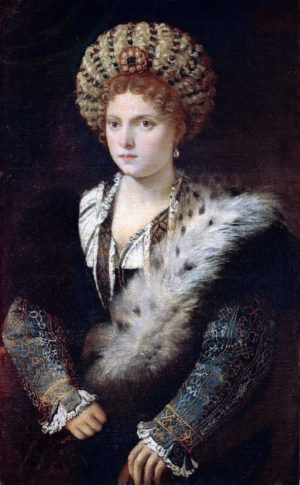
Titian, Isabella d’Este (Isabella in Black), c. 1536, oil on canvas, 102.4 cm x 64.7 cm (Kunsthistorisches Museum)
A vision of beauty
Shown seated, visible in three-quarter length, wearing costly fabric and swathed in fur, the woman’s youth and beauty seem undeniable. Her creamy complexion and fleshy cheeks blush with life, rose-gold hair frames the top of her face in tight curls, and she is crowned with a sumptuous zazara, or turban. A large pearl dangles from her exposed ear, lustrous in the subtle lighting that highlights her face and upper torso. Positioned at a slight angle to the picture plane, with her right shoulder slightly farther back in space, she seems to acknowledge our presence. Her clear, blue-eyed stare penetrates the viewer, gazing cooly at those who gaze upon her. While only tantalizing bits of her flesh are shown—her face, gleaming throat, and hands—through the careful rendering of surface textures, the image seems designed to provoke a sensual response: one yearns to stroke the soft fur of her wrap or touch the velvet of her skin.
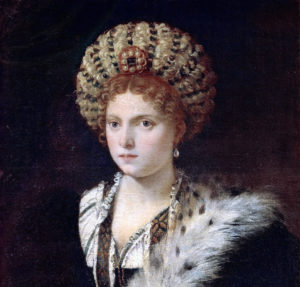
Titian, Isabella d’Este (Isabella in Black) (detail), c. 1536, oil on canvas, 102.4 cm x 64.7 cm (Kunsthistorisches Museum)
This image is a lie, or at the very least, a half-truth. Painted by the Venetian artist Titian around 1536, the work is a portrait of Isabella d’Este, Marchesa of Mantua and wife of the ruler Francesco I Gonzaga. The blushing youth shown here, however, had long passed for Isabella who was in her 60s at the time this work was painted. Isabella’s lost youth aside, such nubile beauty may never have belonged to the marchesa. In her own words Isabella noted:
The portrait by Titian’s hands is of such a pleasing type that we doubt that we were ever, at the age that he represents, of such beauty that is contained in it. [1]
Although Isabella understood this image as her own portrait, Titian’s flattering portrayal is a fantasy. This model of beauty is a carefully constructed conceit reflecting Isabella’s ideal self—how she wanted to be seen or remembered by others—rather than her physical reality. Such self presentation was extremely important to Isabella, as one scholar has noted, Isabella “made herself the object of portrayal more often than any of her contemporaries, male or female.” [2]
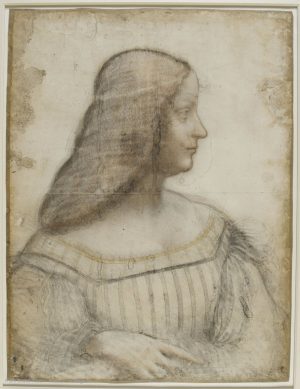
Leonardo da Vinci, Portrait of Isabella d’Este, c. 1499–1500, chalk on paper, 61 x 46.5 cm (Musée du Louvre, Paris)
The art of portraiture was revitalized in the Italian renaissance, in large part due to renewed interest in the portraits of the ancient Greek and Roman traditions. This genre, perhaps above any other, presupposed direct observation. The features of the sitter are those actually observed by the artist in life, or so the idea goes. In reality, artists who created portraits were expected to mediate between art and life, to present the sitter (the person depicted in a portrait) in a flattering way.
A successful portrait was thought to be one that presented the sitter’s individual essence, their unique qualities of temperament and character, as well as their physical appearance. Other extant portraits of Isabella d’Este, including a drawing by Leonardo da Vinci, make it clear that Titian’s vision is just that—an apparition, an invention. Titian’s portrait is more mask than reflection.
The woman behind the mask
Isabella d’Este was among the most celebrated women of her time. She was a fashion trend setter, a potent political force, and an avid art collector. The daughter of Duke Ercole I d’Este of Ferrara, she was raised at one of the most cultured Italian courts of the fifteenth century. Her mother, the Duchess Eleonora of Aragon, was herself daughter of the King of Naples. As the daughter of a duke and granddaughter of a king, Isabella’s nobility of birth outranked that of her Gonzaga husband (a mere Marquis) whom she married in 1490 when she was 16. Her education was equally formidable. Unlike most women—even those of similar social rank—Isabella was well-educated in the classics. She studied Latin with the humanist scholar, Mario Equicola, and was an accomplished dancer and musician. As marchesa of Mantua, she was an able regent during her husband’s frequent absences and, after his death, during the minority of her son. In fact, it was Isabella’s savvy political maneuvering that helped elevate Mantua to a duchy, making the Gonzaga family hereditary Dukes of the region.
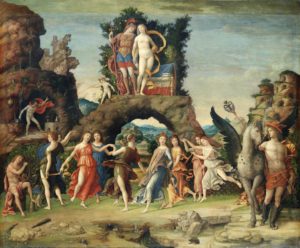
Andrea Mantegna, Mars and Venus (or Parnassus), 1497, tempera and gold on canvas, 159 cm × 192 cm (Musée du Louvre, Paris)
Isabella is best remembered, however, for her patronage of visual art. No other Italian woman did what Isabella did: she amassed a collection of art objects, both ancient and modern, comparable to those of her male peers and for their display had a private studiolo (a space for a painting gallery) and grotta (a room to display her growing collections). Importantly, while most women’s patronage was limited to religious imagery, Isabella collected the culture of pagan ancient Greek and Roman antiquity. She described herself as having an insatiable desire for old things, accumulating gems, cameos, coins, sculpture, and high-quality editions of classical texts. These interests also characterized her patronage of contemporary art. She owned both an ancient statue of Cupid by Praxiteles and a modern reproduction by Michelangelo. Upon the walls of her private rooms were narratives of the Olympian gods and nude figures, subject matter usually reserved for the male patron.
For Isabella, cultural patronage was a means to amplify the glory of the city-state of Mantua and her role, with her husband, as its rightful ruler. To this end, she was conscious of the power of her own visual representation through the art of portraiture. As a woman, even one of her singular social status and powerful connections, she still had to navigate within the established role for her sex. This meant that while she might patronize and collect art in the manner of a man, her behavior and appearance had to meet social expectations for women, namely, that they be obedient, pious, chaste, and (ideally) beautiful. Titian, a master portraitist, was more than able to help her realize these ideals through his art.
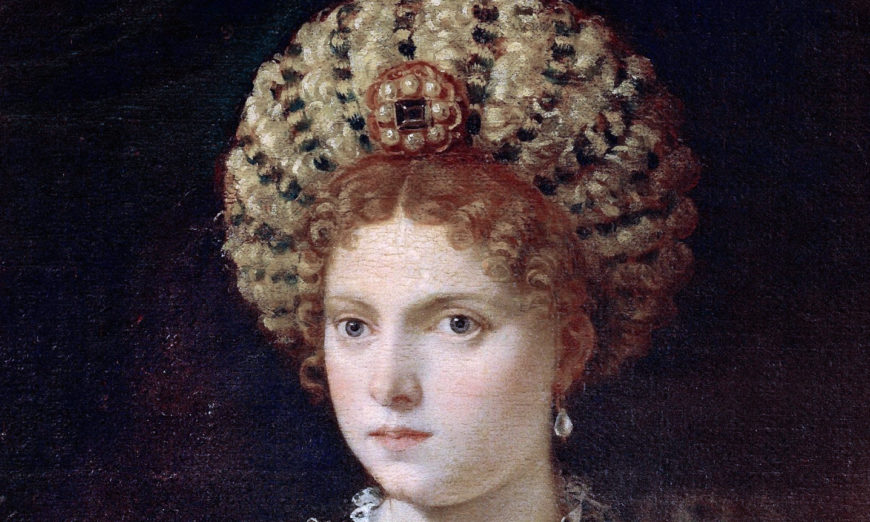
Titian, Isabella d’Este (Isabella in Black), c. 1536, oil on canvas, 102.4 cm x 64.7 cm (Kunsthistorisches Museum)
Challenges for the court lady
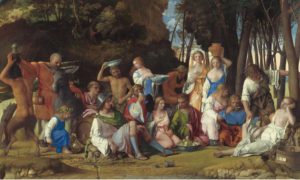
A painting related to lust and sex commissioned by Alfonso d’Este of Ferrara. Giovanni Bellini and Titian, The Feast of the Gods, 1514 and 1529, oil on canvas (National Gallery of Art)
In the princely courts—territories ruled by a sovereign lord—of renaissance Italy, women had more public roles than their counterparts in republican states like Florence. There, public life was dominated by men and women were largely expected to remain within the confines of the domestic sphere, silent and removed from the world of commerce and politics. In contrast, at a court the Lord and his consort (his wife) were together at the center of political and social life. Court women often ruled in their husbands’ absences and supported cultural activities. Such public roles, however, were always in tension with traditions (both Ancient and Christian) that saw women as inferior to men and in need of strict patriarchal control. Isabella, like other women in her position, needed to temper her image—including her collecting habits—to her status as a woman. For example, while both she and her brother, Alfonso d’Este of Ferrara, commissioned scenes of ancient subjects for the walls of their respective studiolos, only Alfonso’s feature themes of lust and sex. Those patronized by Isabella instead celebrate chastity, purity, and beauty—as befit a Lady of the time.

Peter Paul Rubens, copy after Titian, Isabella d’Este in Red, 1605, oil on canvas, 102 cm × 81 cm (Kunsthistorisches Museum)
Isabella’s portraits
Titian’s youthful and idealized image of Isabella reflects contemporaneous expectations for women to be physically beautiful—her fair features were the standard of beauty for the time—as a reflection of their inner virtue. Another portrait of Isabella by Titian created about the same time and known to us now only through a copy by Peter Paul Rubens, showcases a similar idealized beauty. In this second portrait, the bulk of Isabella’s body (at the time she was obese and double-chinned), is presented grandly, her corpulence celebrated in the rich red velvet of her gown. The youth displayed in both works also accords with ideals for renaissance women: a woman’s primary role was procreative. As the consort of a ruler, Isabella was the guarantor of her husband’s lineage, her children were the promise of continuity. Showcasing herself in the flush of fertile youth emphasized her role as the mother of the Gonzaga heirs.
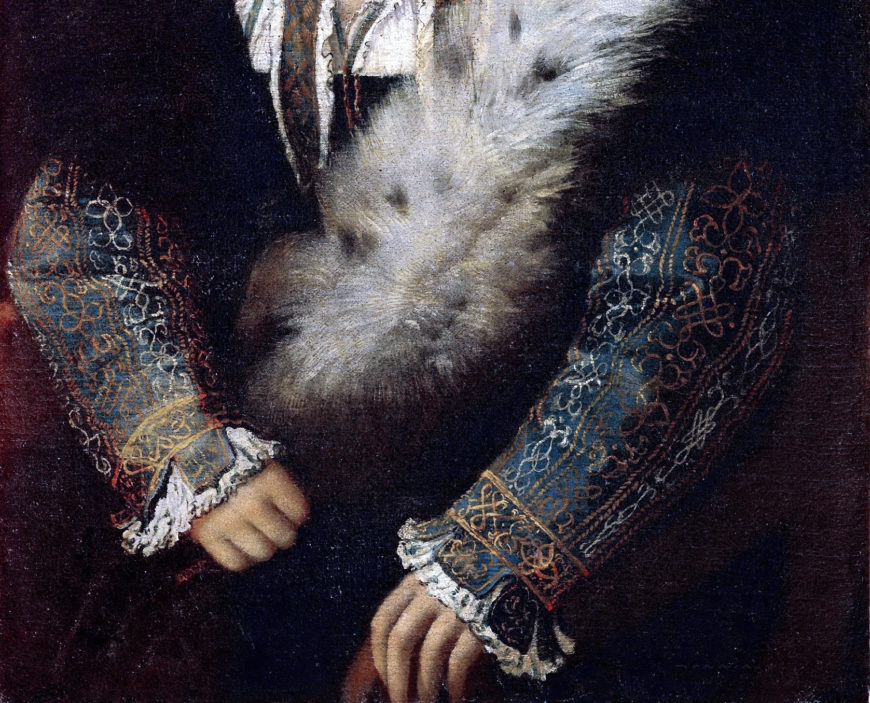
Titian, Isabella d’Este (Isabella in Black) (detail), c. 1536, oil on canvas, 102.4 cm x 64.7 cm (Kunsthistorisches Museum)

Titian, Isabella d’Este (Isabella in Black) , c. 1536, oil on canvas, 102.4 cm x 64.7 cm (Kunsthistorisches Museum)
Isabella’s clothing marks her social identity. In Titian’s portrait, not only does she wear costly fabrics and fur, but the pattern of knots (fantasia dei vinci) on the blue sleeves of her dark gown, picked out in gold and white, were a personal emblem for the Marchesa, designed by Niccolò da Correggio around 1493. The neckline of her camicia (white undergown) and her zazara (turban) were likewise made fashionable by Isabella—these were her own trendsetting fashions put on display.
Isabella was vain and particular about her portraits. Written descriptions of her had to be rewritten according to her wishes before publication and she required portraits to be painted or repainted according to her exacting expectations. Image control was important to her and she was critical of images that she found to be poor likenesses. To meet the Marchesa’s exacting standards required careful mediation of her image. In fact, Titian’s portrait of Isabella in black was not based upon direct observation, but rather upon a portrait of her painted 25 years earlier by the artist Francesco Francia that she gave to him as a model. Likewise, Francia’s portrait of Isabella (now lost) was not itself painted from life but was based upon yet another portrait and verbal description. Such reliance upon pictorial and verbal models over direct observation was commonplace, especially for portraits of aristocratic women. Physical verisimilitude was secondary to desired social appearance.
Titian’s portrait of Isabella is pure artifice. But that does not mean that it is not an accurate portrayal of her. This image may not reflect what Isabella’s physical appearance was in 1536 (or ever), but it does reflect her own wishes for remembrance, her visual taste and keen collector’s eye, her personal pride and savvy understanding of the power of imagery.
Notes:
[1] Isabella to Benedetto Agnello, 29 May 1536. Published by Sylvia Ferrino-Pagden, et. Al., “La Prima donna del mondo”: Isabella d’Este, Fürsten und Mäzenatin der Renaissance (Vienna, 1994), p. 114.
[2] Rona Goffen, Titian’s Women (New Haven: Yale UP, 1997), 87.
Additional resources
Francis Ames-Lewis, Isabella and Leonardo: The Artistic Relationship between Isabella d’Este and Leonardo da Vinci, 1500–1506 (New Haven: Yale University Press, 2012).
Clifford Brown, Isabella d’Este in the Ducal Palace in Mantua: An overview of her rooms in the Castello di San Giorgio and the Corte Vecchia (Rome: Bulzoni, 2005).
David Alan Brown, ed., Virtue and Beauty: Leonardo’s Ginevra de’Benci and Renaissance Portraits of Women (National Gallery of Art, Washington DC, 2001).
Rona Goffen, Titian’s Women (New Haven: Yale UP, 1997).
Sally Hickson, “’To see ourselves as others see us’: Giovanni Francesco Zaninello of Ferrara and the portrait of Isabella d’Este by Francesco Francia” Renaissance Studies (2009) 23.3: 288–310.
Joanna Woods-Marsden, “Ritratto al Naturale: Questions of Realism and Idealism in Early Renaissance Portraits,” Art History 46.3 (Autumn 1987): 209–216.

